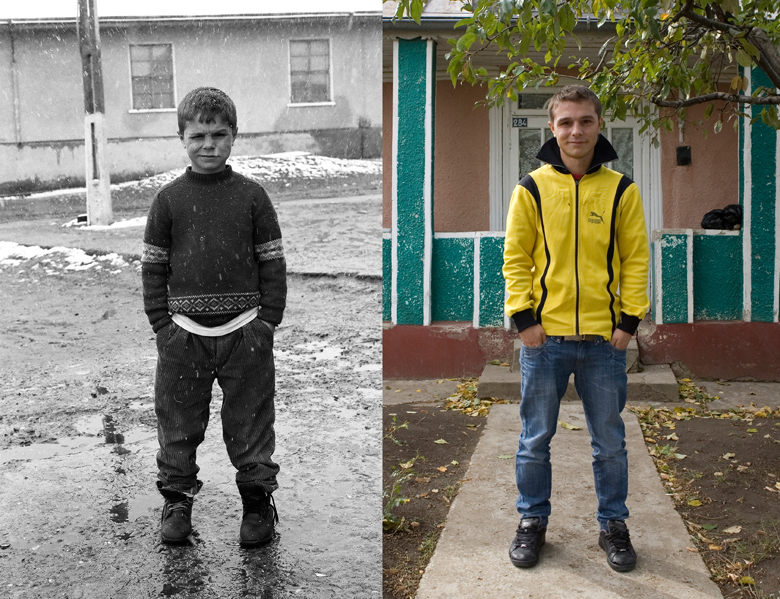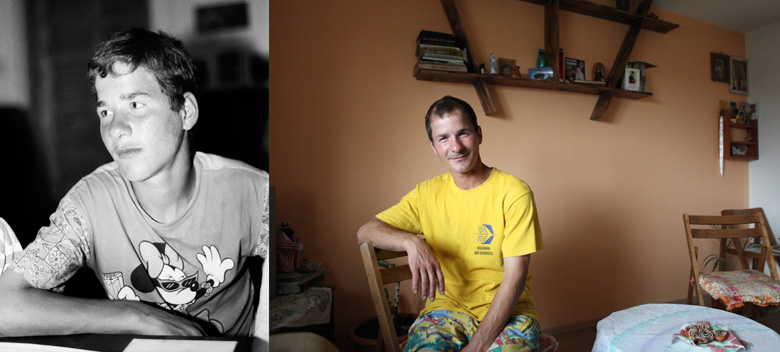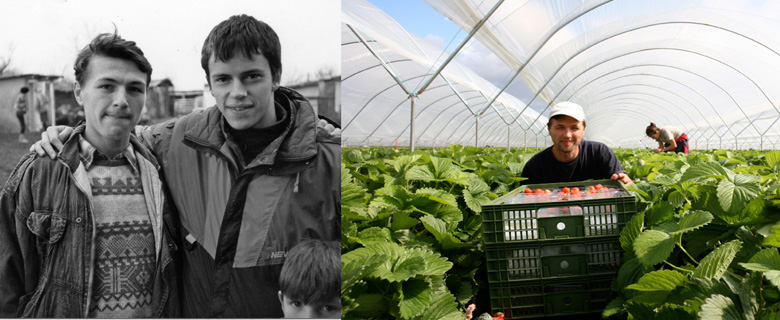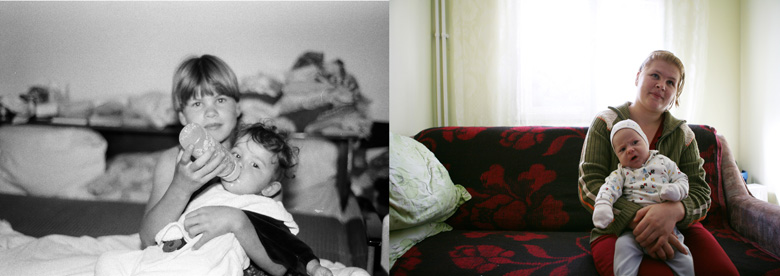Elisabeth Blanchet – Ceausescu’s orphans 20 years on
“Their saucer-eyes peered out from behind bars, their scrawny bodies were strapped to the beds they slept in. Who could forget the terrible images of the Romanian orphans that stared from newspaper front pages following the fall of the Romanian dictator Nicolai Ceaucescu in 1989?”
Constantin in 1995 when he was 10 and in October 2009 enjoying a coffee and a cigarette at the local bar in Popricani. Constantin has never left Popricani. He works as a builder and rents a room in a house in front of the ex-orphanage where he has been knowing the family since he is a child.
After Ceaucescu’s execution, it emerged that hundreds of thousands of uncared and mistreated children had been hidden in crumbling institutions all over the country.
I witnessed the lives of these children first hand when I worked in Romania with a French charity we had created with friends, Action Orphelins. Between 1993 and 2000, I visited the same orphanage in Popricani near Iasi, in the North East of the country and built up a strong relationship with many of the children who were living there life in appalling conditions.
In December 2006, just before Romania joined the EU, I went through all my Romania photo archive from the 90s : I re-discovered hundreds of forgotten images of faces I could never forget. I wondered what had happened to them. So I returned to Romania to track them down.
I undertook this extraordinary adventure thanks to my Romanian friend, Dan, ex-social worker at the orphanage. He helped me find the kids.
After a few trips since 2006, I managed to find 30 kids : Radu had made a success of his life. He had studied veterinary science and after working in the UK for several summers as a fruit picker, was planning to emigrate to the UK. Liliana had become a mother of 3 and lived with her husband in the village. Daniel had become the handyman of the ex-oprhanage. Others had been less lucky: B was sex trafficked to Italy, before being rescued and returned to her village. Adriana had become a single mum begging on the streets of Iasi. Carmen had died years earlier after she had become ill and been admitted to hospital.
Here are a few of their portraits then and now, as well as black and white pictures of the 90s and colour ones of them in the last 4 years.
Florin when he was 12 in 1995 at the orphanage and now in front of the house where he lives, still in the village. In 2007, Florin went to London. He was exploited by a crook who made him wash cars on a huge supermarket car park. He managed to escape and came back to Romania. He now works as a delivery man in a supermarket in Iasi.
Dragos at the orphanage in Popricani in 1993 when he was 8 and now at the Sihla Monastery in Bucovina. Dragos has always been very religious and chose to become a monk when he was 19. He is now 29 and has been living in Sihla for 6 years. He works in the Monastery kitchen and looks after the dining room. «I am happy here. I found my place», he comments.
“After 10 kilometers driving on a rocky mountain path, I reach the Sihla Monastery, where Dragos has been living for the last 6 years. I am impressed with the beauty and the calm of the place. Dragos is here, standing by the door of the huge dining-room. He is wearing a large white apron which covers his monk robe. Meeting him again turns out to be very emotional… I am straight away dragged into the dining room for a local meal and herbal tea made from dried flowers from the mountains… The day goes by very slowly. It’s so quiet up there. I stay most of the time in the shadow of Dragos, observing him in his day routine, which mainly consists in looking after the kitchen and dining room. After a while, I meet an English-speaking monk. I finally have the opportunity to have a deeper conversation with Dragos and I learn what is the most important : Dragos is happy here. He found his place.”
Geta – left – in 1997 at the orphanage in Popricani when she was 13 and now in Ciorogarla, in a covent. Geta became a nun when she was 19, 10 years ago. She is now Sora Christofora.
Mihai in 1995 when he was 12 at the orphanage and now in his house in the outskirts of the village. He has been working in a supermarket in Iasi for a few years and has managed to take a mortgage to buy a piece of land and build his own house.
Radu – left – in 1993 when he was 15 at the orphanage in Popricani and in Scotland in 2007. He spent 3 months on a farm as a fruit picker. Since, he has spent all his summers working on farms in the UK. He got married in Romania in October 2008 and is now a father and lives in Botosani, north of Iasi. Although he qualified as a vet, he struggles to find a job up to his qualifications.
Roxana when she was 12 in 1997 and in October 2009 with her new-born boy in her flat in Iasi. She got married a carpenter called Ion who also grew up at the orphanage.
Vasile in 1995 when he was 11 in Popricani, in the valley behind the orphanage and in October 2011 in his flat in Iasi. Vasile is 27 now and works as a sales representative. He lives in a flat he inherited from an old couple he helped and who had no family.
“Vasile, 27, is the owner of a newly refurbished 2 bedroom flat in the centre of Iasi. “I was in hospital for a sinus operation and I met an old woman who needed a bit of help. We became friends”, he tells us. Then she invited him to her place for a coffee and introduced him to her husband: “They told me that they had no children and that they needed someone to help them regularly with the shopping and other small services. I said I would be very happy to help”. Then, the old lady passed away. “While working, I helped Stefan, the old man, more and more. One day, he told me he would leave me his apartment. It was 3 weeks before he died. I told him I never helped them for that, for getting their money. And I added that the flat should go to his brother”, Vasile recalls. But Stefan insisted and Vasile inherited the flat. Today, he still works as a commercial but his dream is to pass his A-levels and to work for a charity, “to keep on helphing other people”, he says.”
“I have always loved taking pictures of people, places, recording and immortalizing scenes. So, documenting other people’s lives became my job.”
Elisabeth Blanchet is based in London, and she have been a freelance photographer for the last 8 years. She regularly works with Time Out London and other UK papers and magazines, continental press and she gets commissioned or pitch stories and ideas.
“I have my personal projects which find their place in magazines, books, websites. So I keep on doing them! Music, movies and images constantly feed my work till the point I can get obsessed with them. Each job is an open door to new adventures, encounters and life lessons.”
More children stories and other interesting projects
on Elisabeth Blanchet’s website, rediscovered via Cristian Bassa.
Other references:
– Elisabeth Blanchet’s blog and etsy shop;
– an article in Romanian about Elisabeth Blanchet and Popricani in ziaruldeiasi (19/10/2009).
– the successfully funded project (10/07/2011) on ulule.com;
– an interview in French about the project on Deadline6am
(23/09/2011);









[…] […]
[…] http://www.oitzarisme.ro/2012/02/27/elisabeth-blanchet-ceausescus-orphans-20-years-on/ […]